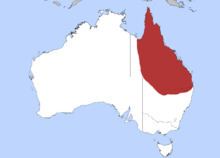Order Anura Genus Cyclorana Higher classification Cyclorana | Phylum Chordata Scientific name Cyclorana novaehollandiae Rank Species | |
 | ||
Similar Cyclorana, Short‑footed frog, Rough frog, Striped burrowing frog, Knife‑footed frog | ||
The New Holland frog (Cyclorana novaehollandiae), or wide-mouthed frog is a large species of burrowing frog native to northern New South Wales and the eastern 3 quarters of Queensland, Australia.
Contents
Description
The New Holland frog is a large species reaching a maximum size of 100 mm. It is normally pale grey, brown or yellowish, occasionally with darker blotches. The belly is white and the throat is speckled. A dark stripe runs from the snout, through the Tympanum and down to the shoulder. There is normally a dark band which runs from under the eye down to the mouth. The thighs are bluish in colour. The toes are slightly webbed.
Ecology and behaviour
This species is associated with black soil plains and flood plains near rivers. They inhabit dams, ditches and claypans in woodland and grassland. Being a burrowing species they spend extended periods underground in order to survive dry conditions. After heavy rains fall during spring, summer and early autumn, frogs become very active and males make a deep "waah" call from in or beside water.
Up to 1000 eggs per clump are laid in a non foamy masses in shallow water. These clumps are initially floating but later sink. An average of 4906 eggs are laid. Tadpoles are large reaching 95-100 mm and are rotund and golden brown. Tadpoles life span is 4 to 6 weeks and metamorphs measure 35-40 mm. They resemble the adult, although the may be bright green in colour.
